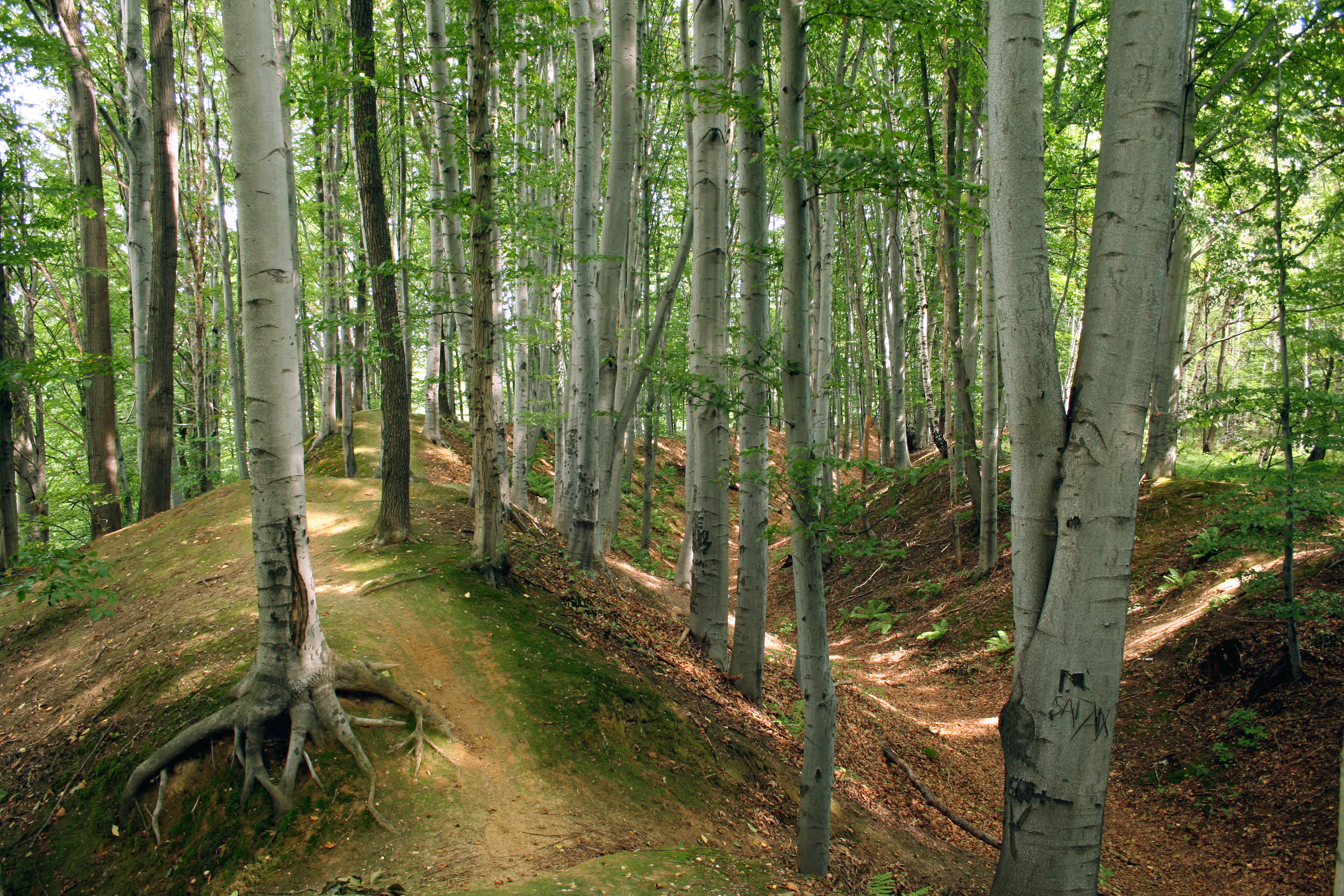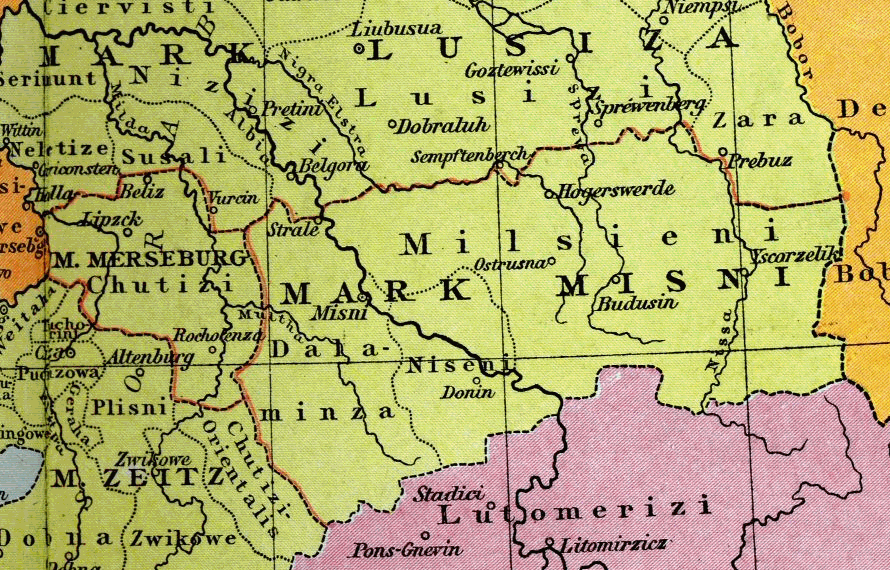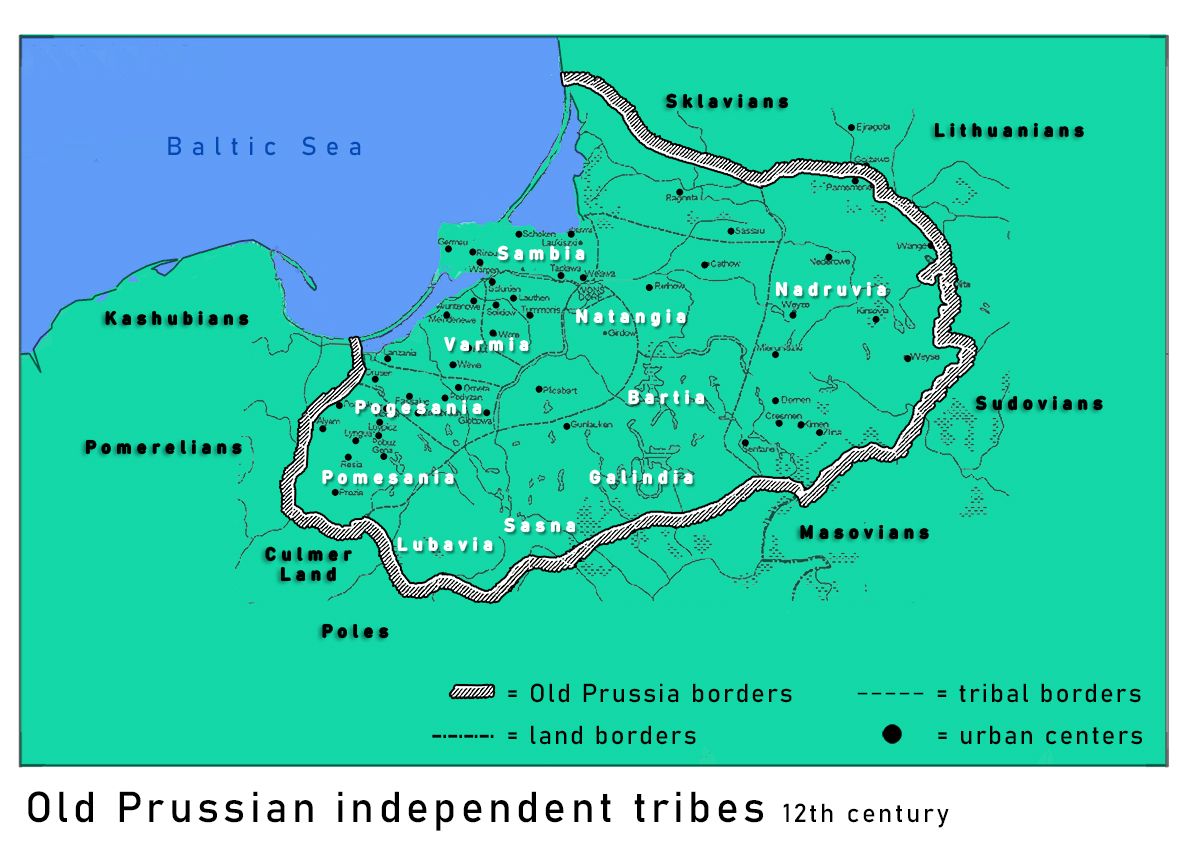|
Geographus Bavarus
The epithet "Bavarian Geographer" ( la, Geographus Bavarus) is the conventional name for the anonymous author of a short Latin medieval text containing a list of the tribes in Central-Eastern Europe, headed (). The name "Bavarian Geographer" was first bestowed (in its French form, "") in 1796 by Polish count and scholar Jan Potocki. The term is now also used at times to refer to the document itself. It was the first Latin source to claim that all Slavs have originated from the same homeland, called the Zeriuani. Origin and content The short document, written in Latin, was discovered in 1772 in the Bavarian State Library, Munich by Louis XV's ambassador to the Saxon court, Comte Louis-Gabriel Du Buat-Nançay. It had been acquired by the Wittelsbachs with the collection of the antiquarian Hermann Schädel (1410–85) in 1571. The document was much discussed in the early 19th-century historiography, notably by Nikolai Karamzin and Joachim Lelewel. The provenance of the documen ... [...More Info...] [...Related Items...] OR: [Wikipedia] [Google] [Baidu] |
Anonymous Work
Anonymous works are works, such as art or literature, that have an anonymous, undisclosed, or unknown creator or author. In the case of very old works, the author's name may simply be lost over the course of history and time. There are a number of reasons anonymous works arise. Description In the United States, anonymous work is legally defined as "a work on the copies or phonorecords of which no natural person is identified as author." Explanations In the case of very old works, the author's name may simply be lost over the course of history and time. In such cases the author is often referred to as Anonymus, the Latin form of "anonymous". In other cases, the creator's name is intentionally kept secret. The author's reasons may vary from fear of persecution to protection of his or her reputation. Legal reasons may also bar an author from self-identifying. An author may also wish to remain anonymous to avoid becoming famous for their work. See also * Anonymous post * Lis ... [...More Info...] [...Related Items...] OR: [Wikipedia] [Google] [Baidu] |
Glopeani
The Goplans or Goplanes ( la, Glopeani, pl, Goplanie) was an early West Slavic tribe that inhabited the central parts of the Kujawy region, with their probable seat at Kruszwica. They might have been named after the Lake Gopło; Kmietowicz believes the Bavarian Geographer (845) overheard it and recorded it (as ''Glopeani''). Many remnants of small strongholds have been unearthed around the lake. The tribe was absorbed by the Polans in the 10th century. Bavarian Geographer The medieval chronicle claims that Glopeani controlled 400 gords (fortified wooden settlements), as if the tribe was dominant in the area; however, the archeological research in Kruszwica has failed to uncover the fortress, although it does indicate the presence of a large settlement. A possible resolution has been offered by Gerard Labuda who hypothesized that the "Goplanie" were the same as, or a part of, the Polans, whose main center was located at Gniezno. The chronicle doesn't indicate the location of th ... [...More Info...] [...Related Items...] OR: [Wikipedia] [Google] [Baidu] |
Bavarian State Library
The Bavarian State Library (german: Bayerische Staatsbibliothek, abbreviated BSB, called ''Bibliotheca Regia Monacensis'' before 1919) in Munich is the central " Landesbibliothek", i. e. the state library of the Free State of Bavaria, the biggest universal and research library in Germany and one of Europe's most important universal libraries. With its collections currently comprising around 10.89 million books (as of 2019), it ranks among the best research libraries worldwide. Moreover, its historical stock encompasses one of the most important manuscript collections of the world, the largest collection of incunabula worldwide, as well as numerous further important special collections. Its collection of historical prints before 1850 number almost one million units. The legal deposit law has been in force since 1663, regulating that two copies of every printed work published in Bavaria have to be submitted to the Bayerische Staatsbibliothek. This law is still applicable today. ... [...More Info...] [...Related Items...] OR: [Wikipedia] [Google] [Baidu] |
Latin
Latin (, or , ) is a classical language belonging to the Italic branch of the Indo-European languages. Latin was originally a dialect spoken in the lower Tiber area (then known as Latium) around present-day Rome, but through the power of the Roman Republic it became the dominant language in the Italian region and subsequently throughout the Roman Empire. Even after the fall of Western Rome, Latin remained the common language of international communication, science, scholarship and academia in Europe until well into the 18th century, when other regional vernaculars (including its own descendants, the Romance languages) supplanted it in common academic and political usage, and it eventually became a dead language in the modern linguistic definition. Latin is a highly inflected language, with three distinct genders (masculine, feminine, and neuter), six or seven noun cases (nominative, accusative, genitive, dative, ablative, and vocative), five declensions, four verb conjuga ... [...More Info...] [...Related Items...] OR: [Wikipedia] [Google] [Baidu] |
Golensizi
The Golensizi ( pl, Golęszycy, Gołęszycy, Golęszyce, Gołęszyce, Gołężyce, cz, Holasici, german: Golensizen) were a tribe of West Slavs, specifically of the Lechitic tribes (one of the Silesian tribes), living in the Early Middle Ages and inhabiting southern territories of what was later known as Upper Silesia, on the upper Oder River. The area was settled by Slavs after it was abandoned by the Germanic tribes between the 5th and 6th century. Later the organised tribe of Golensizi according to Bavarian Geographer had 5 ''civitates'' (strongholds). Among them most notable were located in Lubomia (the biggest), Chotěbuz and Hradec nad Moravicí which was in 1155 mentioned as ''Gradice Golenzicezke''. Some of them were most probably destroyed at the end of 9th century by Svatopluk I, the king of Great Moravia. The settlement from the destroyed Chotěbuz moved to Castle Hill (Góra Zamkowa) in what is today a city of Cieszyn. Some historians claim that the area was then ruled ... [...More Info...] [...Related Items...] OR: [Wikipedia] [Google] [Baidu] |
Opolini
Opolans ( pl, Opolanie; cs, Opolané; german: Opolanen) were the West Slavic tribe that lived in the region of upper Odra. Their main settlement ( gord) was Opole. They were mentioned in the Bavarian Geographer, under the name Opolini, as one of the seven tribes living in Silesia (Silesian tribes). The other six were: Dziadoszanie, Golęszyce, Ślężanie, Trzebowianie, Bobrzanie and Lupiglaa (often identified with Głubczyce). The name Opolans derives from a Slavic term ''opole'', that meant a specific form of self-governing used among the West Slavs. Early medieval ''opole'' transformed into an administrative governing form used in Early Medieval Poland mainly to collect taxes. According to the Geographer Opolans possessed 20 gords in what was later known as Upper Silesia such as Opole and Toszek. Presumably their place of cult was the Saint Anna mountain. Opolanie's territories were conquered by Great Moravia in 875 and were probably incorporated into the Přemyslid Boh ... [...More Info...] [...Related Items...] OR: [Wikipedia] [Google] [Baidu] |
Milzane
The Milceni or Milzeni ( cs, Milčané; german: Milzener; pl, Milczanie) were a West Slavic tribe, who settled in the present-day Upper Lusatia region. They were first mentioned in the middle of the 9th century AD by the Bavarian Geographer, who wrote of 30 ''civitates'' which possibly had fortifications. They were gradually conquered by Germans during the 10th century. Modern descendants of the Milceni are the Sorbs of the Free State of Saxony, Germany.Institut für Sorabistik.About Sorbian Language". Accessed November 8, 2006. History The Milceni travelled to Upper Lusatia in the 7th century during the Migration Period.''Bautzen.de''History. Accessed November 8, 2006. The exact borders of their settlement area are disputed. It is generally accepted that their fielded land had fruitful loess soil and had dimensions of approximately 50 km from east to west and 20 km from north to south. The northern border was in swampy and partially infertile terrain, while the south ... [...More Info...] [...Related Items...] OR: [Wikipedia] [Google] [Baidu] |
Sleenzane
The Silesians ( pl, Ślężanie) were a tribe of West Slavs, specifically of the Lechitic/Polish group, inhabiting territories of Lower Silesia, near Ślęża mountain and Ślęza river, on both banks of the Oder, up to the area of modern city of Wrocław. They were the first permanent inhabitants of the site of Wrocław where they build a fort on Ostrów Tumski in the 9th century or earlier, which at the time was an island on the Oder. Their tribal name was derived from the name of the mountain and the river, which most likely came from the old Polish word ''Ślagwa'', meaning "humid", which refers to the climate of the area. The name of the region in turn, Silesia, comes from their language and tribal name.Jasienica, pg. 32 Along with the Opolans, the Ślężanie comprised one of the two major tribes in Silesia. They bordered the Dziadoszanie to their north. The Biezunczanie's territory lay to the west. Other, more minor, Silesian tribes of the time included the Golensizi, ... [...More Info...] [...Related Items...] OR: [Wikipedia] [Google] [Baidu] |
Uuislane
The Vistulans, or Vistulanians ( pl, Wiślanie), were an early medieval Lechitic tribe inhabiting the western part of modern Lesser Poland."The main tribe inhabiting the reaches of the Upper Vistula and its tributaries was the Vislane (Wislanie) who, by the mid-ninth century were considered by the neighbouring Moravians as "very powerful" The expansionist policy of the Christian Moravian state led to eventual conflict with the pogan Vislane. ending in the defeat of the latter and their annexation to the Great Moravian Empire between Ad 875-879" . n:''Trade and urban development in Poland: an economic geography of Cracow''. Francis W. Carter. P. 46. 1994 op. cit. L. Hajdukiewicz and M. Karaś. ''The Jagiellonian University: Traditions, The Present, The Future''. Cracow. 1978, p. 17. Etymology Their name derives from the hydronym of the river Vistula, meaning "inhabitants of Vistula"; the region is mentioned as ''Uuislane'' by the Bavarian Geographer, ''v Vislè'' and ''v Vislèh'' ... [...More Info...] [...Related Items...] OR: [Wikipedia] [Google] [Baidu] |
Hungarians
Hungarians, also known as Magyars ( ; hu, magyarok ), are a nation and ethnic group native to Hungary () and historical Hungarian lands who share a common culture, history, ancestry, and language. The Hungarian language belongs to the Uralic language family. There are an estimated 15 million ethnic Hungarians and their descendants worldwide, of whom 9.6 million live in today's Hungary. About 2–3 million Hungarians live in areas that were part of the Kingdom of Hungary before the Treaty of Trianon in 1920 and are now parts of Hungary's seven neighbouring countries, Slovakia, Ukraine, Romania, Serbia, Croatia, Slovenia, and Austria. Significant groups of people with Hungarian ancestry live in various other parts of the world, most of them in the United States, Canada, Germany, France, the United Kingdom, Chile, Brazil, Australia, and Argentina. Hungarians can be divided into several subgroups according to local linguistic and cultural characteristics; subgroups with distinc ... [...More Info...] [...Related Items...] OR: [Wikipedia] [Google] [Baidu] |
Caziri
The Khazars ; he, כּוּזָרִים, Kūzārīm; la, Gazari, or ; zh, 突厥曷薩 ; 突厥可薩 ''Tūjué Kěsà'', () were a semi-nomadic Turkic people that in the late 6th-century CE established a major commercial empire covering the southeastern section of modern European Russia, southern Ukraine, Crimea, and Kazakhstan. They created what for its duration was the most powerful polity to emerge from the break-up of the Western Turkic Khaganate. Astride a major artery of commerce between Eastern Europe and Southwestern Asia, Khazaria became one of the foremost trading empires of the early medieval world, commanding the western marches of the Silk Road and playing a key commercial role as a crossroad between China, the Middle East and Kievan Rus'. For some three centuries (c. 650–965) the Khazars dominated the vast area extending from the Volga-Don steppes to the eastern Crimea and the northern Caucasus. Khazaria long served as a buffer state between the Byzantin ... [...More Info...] [...Related Items...] OR: [Wikipedia] [Google] [Baidu] |
Bruzi
Old Prussians, Baltic Prussians or simply Prussians (Old Prussian: ''prūsai''; german: Pruzzen or ''Prußen''; la, Pruteni; lv, prūši; lt, prūsai; pl, Prusowie; csb, Prësowié) were an indigenous tribe among the Baltic peoples that inhabited the region of Prussia, at the south-eastern shore of the Baltic Sea between the Vistula Lagoon to the west and the Curonian Lagoon to the east. The Old Prussians, who spoke an Indo-European language now known as Old Prussian and worshipped pre-Christian deities, lent their name, despite very few commonalities, to the later, predominantly Low German-speaking inhabitants of the region. The duchy of the Polans under Mieszko I, which was the predecessor of the Kingdom of Poland, first attempted to conquer and baptize the Baltic tribes during the 10th century, but repeatedly encountered strong resistance. Not until the 13th century were the Old Prussians subjugated and their lands conquered by the Teutonic Order. The remaining Old Prus ... [...More Info...] [...Related Items...] OR: [Wikipedia] [Google] [Baidu] |







